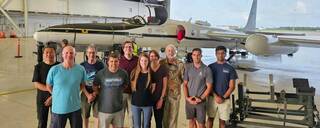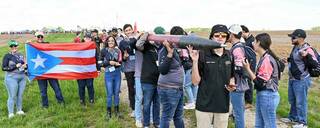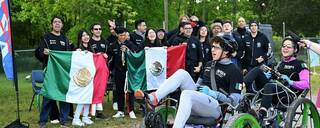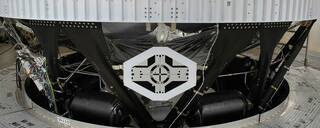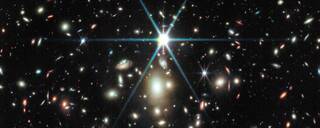Week of August 14 – August 18, 2023.
Global Collaboration Leads to New Discoveries in Lightning Research
A group of researchers from the University of Bergen (Norway), the U.S. Naval Research Laboratory (NRL), and three NASA centers have just completed a month of flights to study lightning and the vast energy fields around thunderclouds in our atmosphere. Their new observations will help scientists gain further insight into how lightning forms and help them better predict when storms could turn severe. With operations based out of Tampa, Florida, the ALOFT field campaign logged approximately 60 hours of flight time across Central America and the Caribbean. The team used NASA Armstrong’s ER-2 aircraft to fly near thunderclouds as tall as 18 kilometers (10 miles) in altitude in order to measure gamma-ray glows and flashes produced by the electric fields of thunderclouds. ALOFT is short for Airborne Lightning Observatory for Fly’s Eye GLM Simulator and Terrestrial gamma-ray flashes.
NASA Accepting Proposals for 2024 Student Launch Challenge
The 24th year of NASA’s Student Launch challenge has officially begun with the release of the 2024 handbook, providing in-depth guidance on submitting proposals, safety information, competition rules, and more. Interested teams should view the website and handbook for eligibility requirements and instructions on submitting proposals by 8 a.m. CDT on Sept. 11, 2023. Student Launch is an annual competition which challenges middle school, high school, and college students to design, build, test, and launch a high-powered amateur rocket with a scientific or engineering payload. After a team is selected, they must meet documentation milestones and undergo detailed reviews throughout the school year. The 2024 on-site event is scheduled for April 10-14, 2024, with final launches April 13 at Bragg Farms in Toney, Alabama, minutes north of NASA’s Marshall Space Flight Center
NASA Seeks Student Ideas for 2024 Human Exploration Rover Challenge
Students interested in designing, developing, building, and testing rovers for Moon and Mars exploration are invited to submit their proposals to NASA through Thursday, Sept. 21. The complete details on how to participate in NASA’s Human Exploration Rover Challenge are available online. To learn more, challenge experts are hosting two webinars at 10 a.m. EDT, and again at 6 p.m., on Thursday, Aug. 24. The virtual sessions will outline the proposal processes, and requires pre-registration.
Technicians Add ‘Target’ to NASA Artemis II Rocket Hardware
A critical auxiliary target for NASA’s Artemis II mission is ready for flight following testing at United Launch Alliance’s (ULA) Florida facility. Teams with the company added the target onto the in-space propulsion stage for NASA’s SLS (Space Launch System) rocket at ULA’s Delta Operations Center at Cape Canaveral Space Force Station in Florida, May 16. Following the safe separation of NASA’s Orion spacecraft from the rocket’s upper stage, the four astronauts aboard Orion will use the target affixed to the in-space stage for a proximity operations demonstration to test Orion’s piloting qualities. The recently installed target underwent illumination testing in May to ensure the target will be visible in the different lighting conditions of space.
Webb Reveals Colors of Earendel, Most Distant Star Ever Detected
NASA’s James Webb Space Telescope has followed up on observations by the Hubble Space Telescope of the farthest star ever detected in the very distant universe, within the first billion years after the big bang. Webb’s NIRCam (Near-Infrared Camera) instrument reveals the star to be a massive B-type star more than twice as hot as our Sun, and about a million times more luminous. The star, which the research team has dubbed Earendel, is located in the Sunrise Arc galaxy and is detectable only due to the combined power of human technology and nature via an effect called gravitational lensing. Both Hubble and Webb were able to detect Earendel due to its lucky alignment behind a wrinkle in space-time created by the massive galaxy cluster WHL0137-08. The galaxy cluster, located between us and Earendel, is so massive that it warps the fabric of space itself, which produces a magnifying effect, allowing astronomers to look through the cluster like a magnifying glass.
For more information or to learn about other happenings at NASA’s Marshall Space Flight Center, visit NASA Marshall. For past issues of the ICYMI newsletter, click here.



























